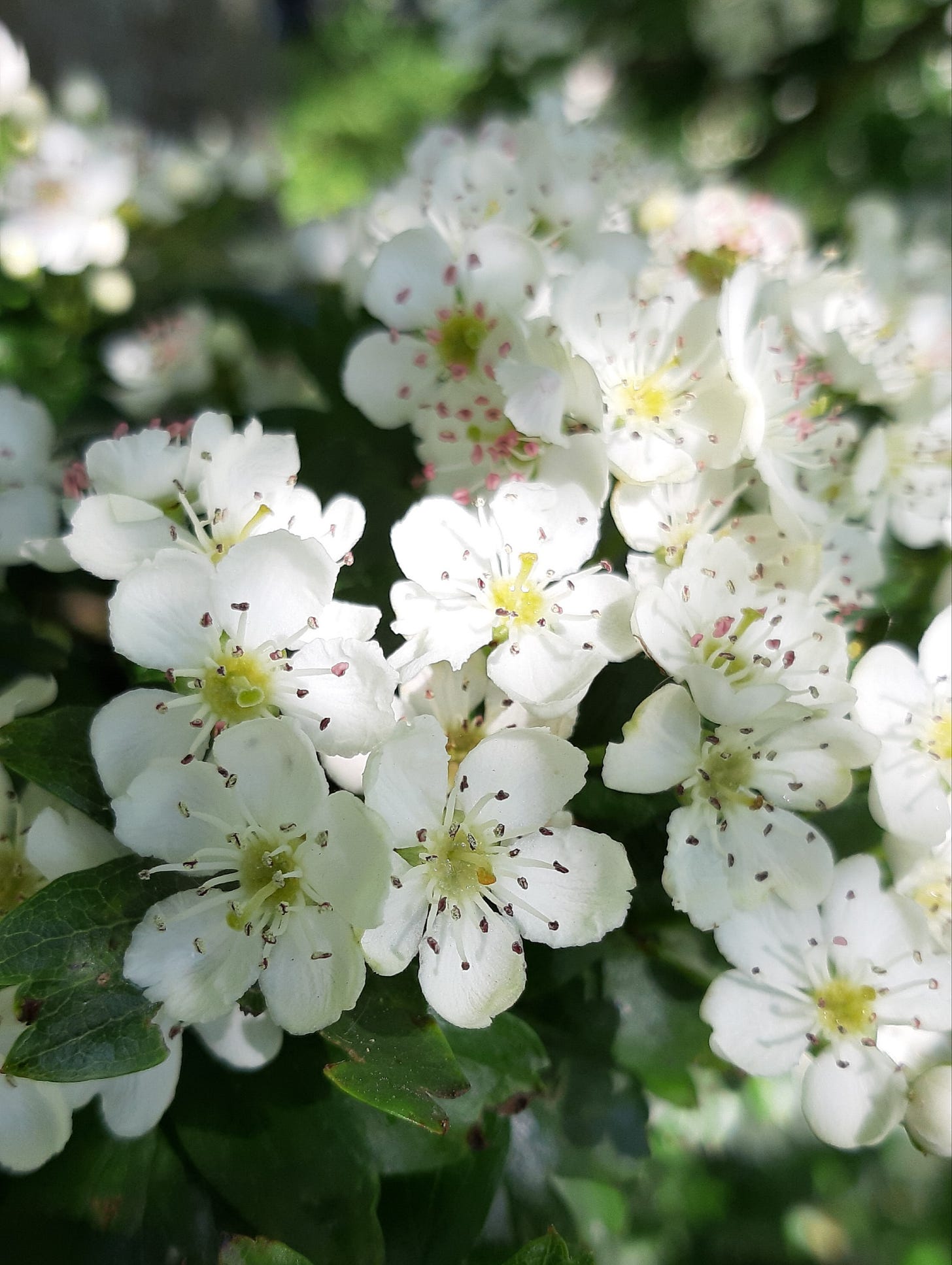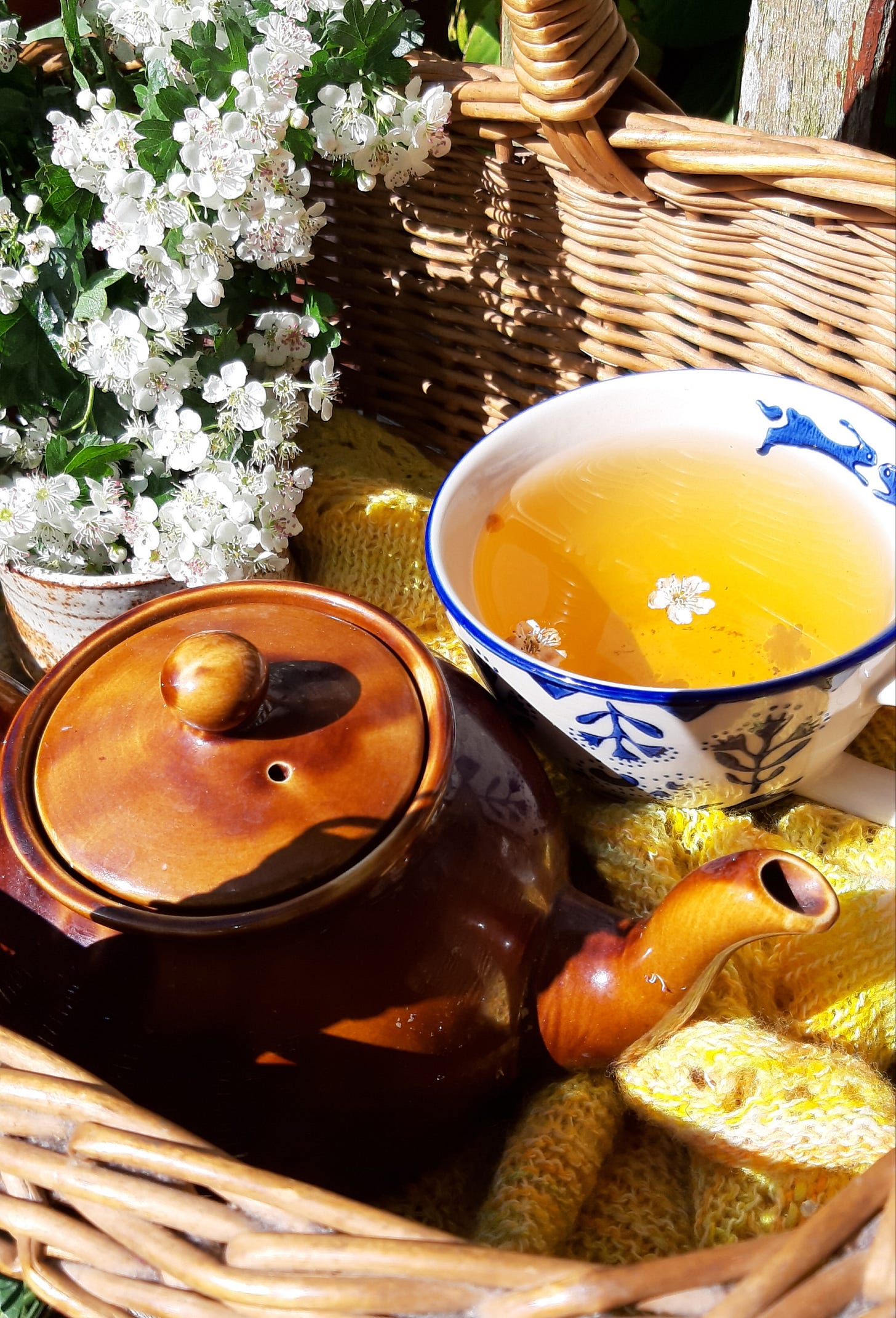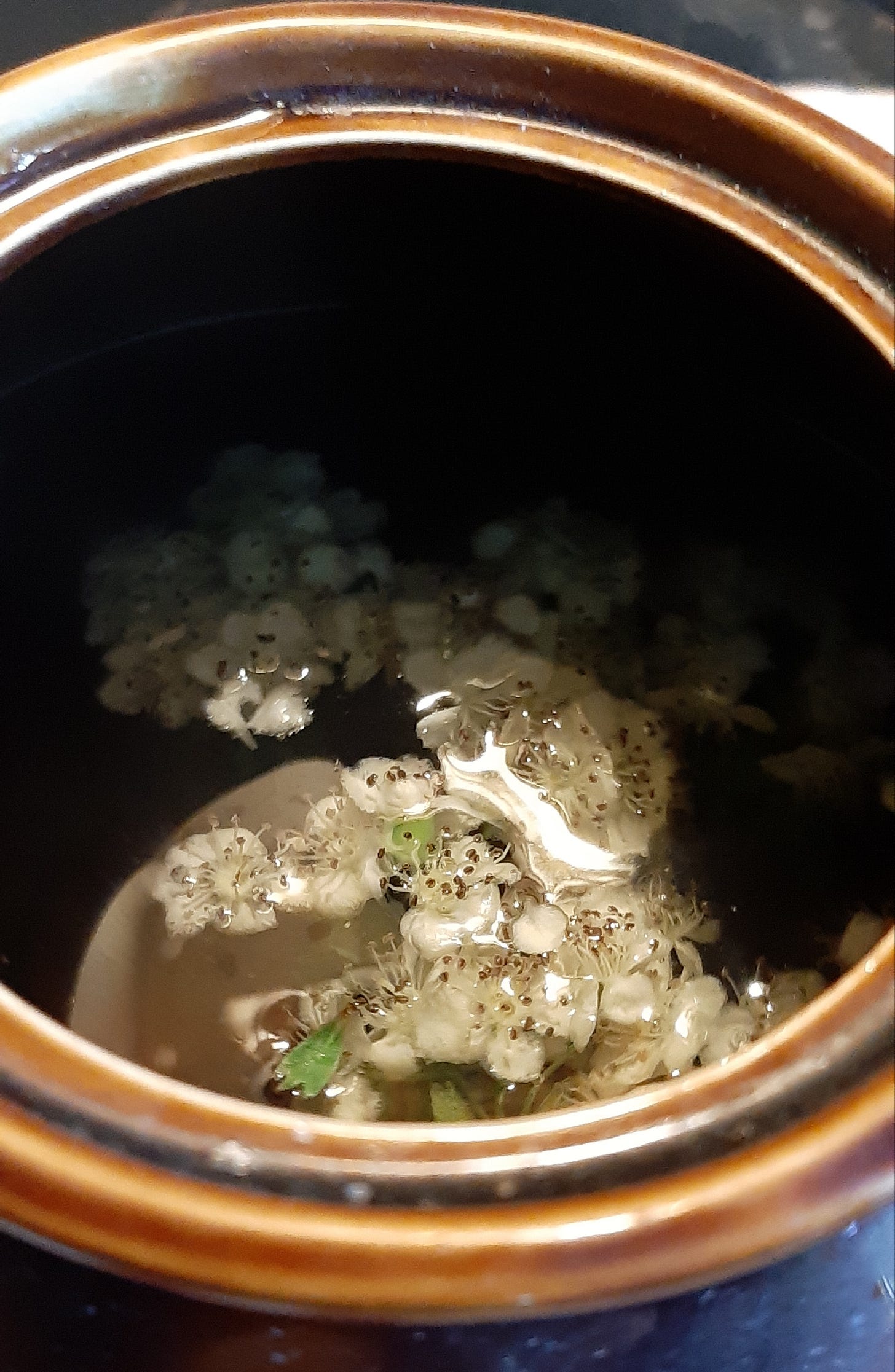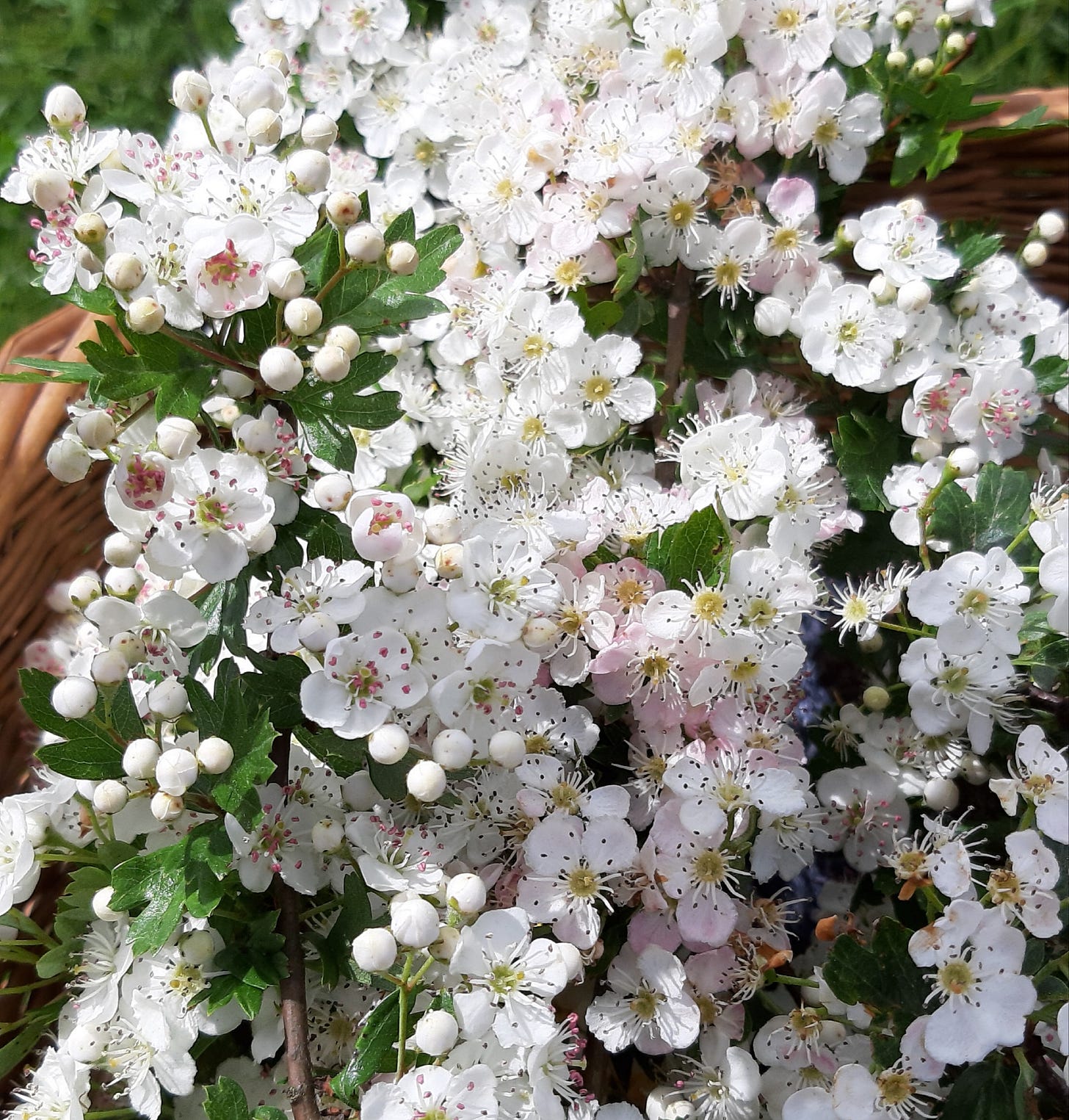Journeying with the Holy Thorn ~ Days 5 & 6
The Plant Spirit Challenge 2023 , Day 5: Research Medicine & Day 6: Make Medicine
Day 5 and 6 of the #PlantSpiritChallenge are Research and Make Medicine.
Day 5: Research Medicine
Even before I began this challenge I already knew that hawthorn's main medicinal benefit is to the heart, both physically and emotionally. I have experience of the latter as I was prescribed tinctures of hawthorn and nettle for adrenal fatigue in 2013 and found both really helpful.
Julie Bruton-Seal and Matthew Seal's book of wonders, 'Hedgerow Medicine: Harvest and Make Your Own Herbal Remedies', explains that, "hawthorn is a superb heart and circulatory tonic, protecting and strengthening the heart muscle and its blood supply. It improves blood circulation around the body, and can be used to treat a wide range of circulatory problems. Hawthorn also affects the emotional side of what we think of as the 'heart', by calming and reducing anxiety, helping with bad dreams and insomnia, smoothing menopausal mood swings."
That would explain why I felt drugged and drowsy after a night of dreaming with hawthorn for day 4, that and the folklore that sleeping under a hawthorn tree might cause us to be whisked off into faeryland!
'Hedgerow Medicine' also tells us that the use of hawthorn for the heart and circulation is a "relatively new use of the plant", citing a Dr Green in County Clare, Ireland who, during the Victorian era, was successful in treating patients with heart disease but refused to reveal how he was doing so. On his death in 1894, his daughter explained that he had been using a tincture of ripe hawthorn berries. In 1896, the story was written up in the 'New York Medical Journal' and the use of hawthorn as a heart tonic was soon popular in both the US and Britain.
However, it isn't entirely true that the use of hawthorn as a heart healer wasn't known before the late 1800s. Although Old European herbals more often suggest hawthorn for 'the stone', for drawing out splinters, and occasionally for treating gout and insomnia, as long ago as 1653, Nicolas Culpeper was suggesting hawthorn seeds "beaten to a powder and drunk in wine" to treat dropsy. A more modern name for dropsy is edema, or fluid retention, often caused by congestive heart failure.
Unlike foxglove, from which digitalis is derived, and many commercial remedies, hawthorn is gentle and has few side effects so can not only be used to treat heart problems but can also be employed as a preventative medicine. It is able to dilate the coronary arteries and strengthen the heart muscle without raising blood pressure. In fact, it can help to normalise blood pressure, so that if it's high hawthorn will lower it and if it's low it will raise it.
Hawthorn is also calming to the spirit, helping with mood swings in menopause, restlessness, anxiety, and ADHD. She also helps us to maintain healthy personal boundaries.
The berries, leaves, and flowers of hawthorn can all be used used in healing. Referring to 'Hedgerow Medicine' again, we're told to use her in these ways:
Berries:
Hawthorn fruit leather ~ heart and circulatory tonic
Hawthorn berry syrup ~ heart tonic, hardening of the arteries, abnormal blood pressure, mild angina, anxiety, restlessness.
Flowers, leaves, and berries:
Hawthorn tincture ~ heart tonic, hardening of the arteries, abnormal blood pressure, palpitations, irregular heart beat, mild angina, anxiety, restlessness, intermittent claudication (where the blood vessels of the legs are supplying insufficient oxygen).
I love the description of hawthorn offered by The Herbal Academy, who tell us that she, "offers various actions that lovingly guide us through the modern world. While we may be bombarded with information and opinions, hawthorn stands unmoved, ready to hold us steadfast." They also suggest her as an aid to the digestion. Certainly she is used in Chinese medicine in this way.
What a loving and generous spirit hawthorn brings. There are many plants and herbs which are indicated for a huge range of maladies and I love that hawthorn centres herself so fully around the heart and oxygenating the blood. May, when the hawthorn blossom is at its most dramatic, contains the Feast Day of St Melangell, protectress of hares, and I am reminded that hares not only have comparatively larger hearts than any other mammal but that their broad noses hide turbinate bones which enable them to maximise oxygen intake. Hare is hawthorn medicine made flesh!
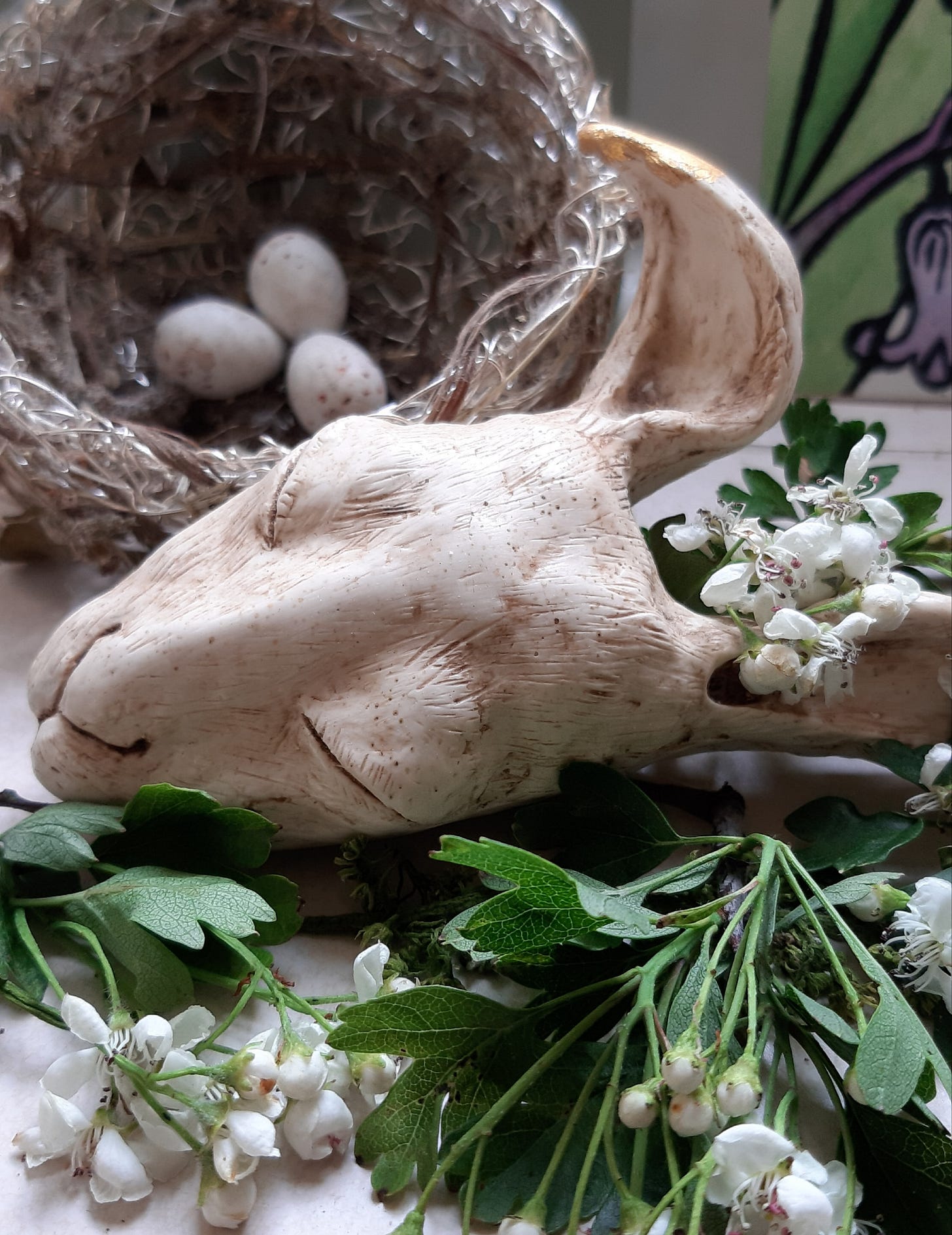
I love too that hawthorn invites us to take time over our healing. The best, and most effective, hawthorn tincture is made by gathering her leaves and flowers in the spring, making and straining the tincture, then adding her berries in the autumn before straining again for use. Our hearts need gentleness and the offering of time. That is medicine in itself.
I have had some powerful healing experiences with hawthorn since beginning this challenge and I will write about those in my next sharing for Day 6: Make Medicine.
Day 6: Make Medicine
I have been taking hawthorn tea made from dried leaves and flowers every night since I began the Plant Spirit Challenge. I began doing so as an act of mindfulness and connection, a building of relationship, but it has already had unexpected healing benefits; so much so that now that I have used up my dried hawthorn supplies I have resolved to gather lots more in the next few weeks so that I can continue taking it. I also plan to make a hawthorn tincture as I'm not sure that I have the space to store enough dried hawthorn for tea to see me through the winter months!
Nevertheless, I decided that for the 'make medicine' prompt of the Plant Spirit Challenge I would concentrate on tea drinking. Although, of course, herbal teas are better described as infusions, decoctions, or tisanes. Rather than use dried hawthorn as I have been doing, I decided to use fresh flowers and leaves to see whether they had a different quality.
I let my infusion sit for ten minutes before straining it and then drank it in the hedgehermitage garden in the sunshine, which of course was a lovely experience in itself. On drinking it I felt, as I always do when drinking hawthorn tea, an expanding of my heart and a huge sense of well-being. I paid a little more attention this time though and I can only describe the feeling it gave me as one of benevolence. I loved then reading later that the Herbal Academy describe hawthorn as, "a lovely and generous plant to use in times of tenderness, especially when grief is present. It can soften our hearts as well as promote forgiveness of self and others. When one feels in need of a hug, turn towards hawthorn." From my experience I can certainly say that this is true.
It was interesting too that our cat visitor, Henhouse, decided to lick my right ankle whilst I was drinking my hawthorn tea, something that he has never done before. So determined was he that he made his way almost up to my knee, despite having to pop his head up my trouser leg! Later, when I sat down to make some hawthorn art, he returned and began his ministrations on my left leg. I do have some circulation problems in my lower legs, which hawthorn is a medicine for, and it felt that Henhouse had intuitively chosen to aid my healing. Cats amaze me more and more by the day.
Which brings me to the benefits that I have already found by drinking an infusion of hawthorn each night before bed. Because of my poor circulation and osteoarthritis, I often experience pain when lying down and find it difficult to sleep. Having been drinking the tea for one week, I found that I experienced no pain at all. Bliss.
Hawthorn is also helping me with my heart boundaries, teaching me how to surround my often beleaguered heart with both strong thorns and soft petals; the perfect combination to offer protection without causing a shutting down or closing off.
It is of course very early in my relationship with hawthorn and so I am sitting quietly and observing these effects, holding them lightly and without expectation, but I am deeply grateful for the wild medicine and possibilities of healing that hawthorn has already offered.
(An update: sharing this writing two weeks after completing Day 6 I can report that the pain in my legs has certainly not gone entirely but that it has significantly lessened. I feel that drinking hawthorn tea is working towards my healing on more subtle levels too but I am yet to understand what those are.)
A little disclaimer: I am not a trained medical herbalist and can only describe my own personal experiences. Do consider seeking advice if you are thinking of embarking on a course of treatment.
Day 5 references:
'Hedgerow Medicine: Harvest and Make Your Own Herbal Remedies', Julie Bruton-Seal and Matthew Seal, Merlin Unwin Books, 2008
https://en.wikipedia.org/wiki/Nicholas_Culpeper
https://archive.org/details/culpeperscomplet00culpuoft/page/178/mode/2up
https://www.botanical.com/botanical/mgmh/h/hawtho09.html
https://www.herbrally.com/monographs/hawthorn
https://theherbalacademy.com/hawthorn-offerings/
https://www.poison.org/articles/hawthorn-as-an-herbal-remedy-214
https://christopherhobbs.com/library/articles-on-herbs-and-health/hawthorn-for-the-heart/
https://www.verywellhealth.com/the-benefits-of-hawthorn-89057
https://www.aafp.org/pubs/afp/issues/2010/0215/p465.html
https://www.webmd.com/vitamins-and-supplements/hawthorn-uses-and-risks
Day 6 references:
https://theherbalacademy.com/hawthorn-offerings/




